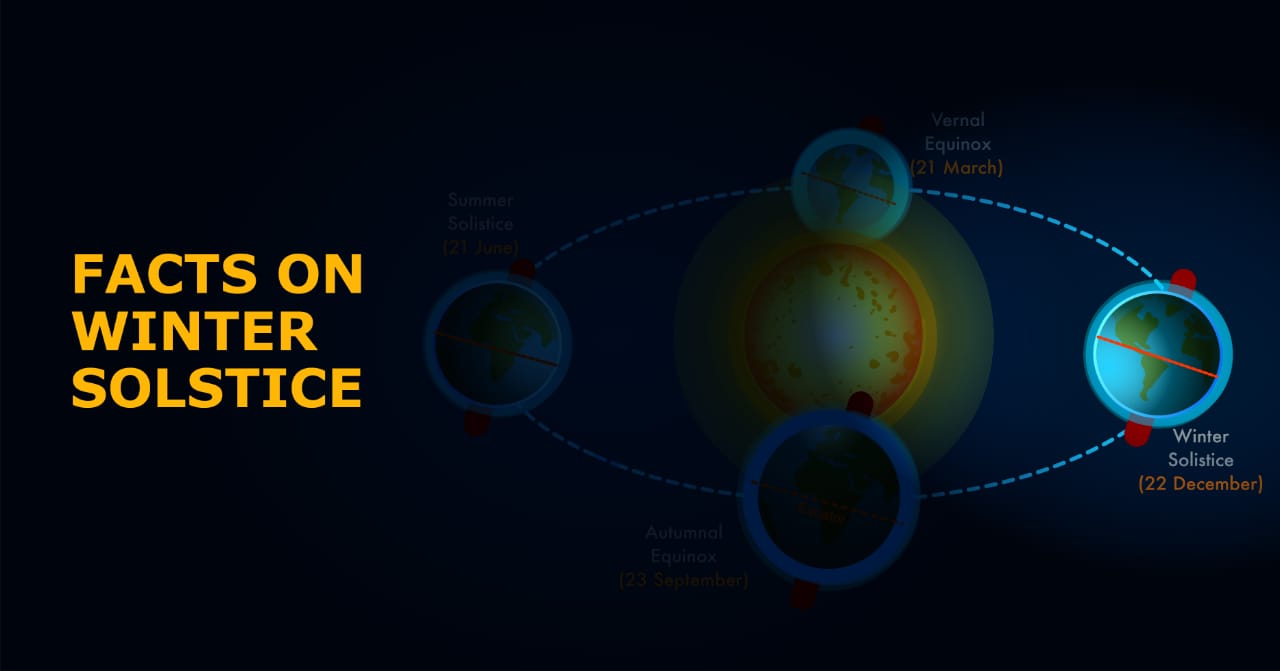FACTS ABOUT WINTER SOLSTICE
 Posted On
Posted On
687 total views, 1 views today
“Time is defined so that motion looks simple”
: John Archibald Wheeler
Our Mother Earth is in constant motion. She is wheeling around , at her own pace and time and it’s in this wheeling that “we“, her children get rhythm of life. Yes, with Earth’s movements, we experience the phenomenon of day and night and the annual change of seasons. Earth’s motion or movements are broadly of two types: Rotation, wherein she spins around her axis in 24 hours and by virtue of which we observe day and night; Another is the annual movement of the Earth around the Sun, known as Revolution, where she revolves around her orbit centring the Sun and this annual movement of her creates the “rhythm of seasons”. These two motions of the Earth are pivotal for any natural phenomenon in our lives …So if you think why the rays are so scorching in Summer afternoons or if you yearning for some sunrays to busk you in the winter afternoon , but unfortunately can’t, then don’t panic , but just understand the scientific ways patiently for all these happenings.
The Revolution of the Earth around it’s orbit is responsible for natural phenomenon of seasons, as well as Solstices and Equinoxes. The word Solstice is derived from a Latin Word and refers to as “Stalled Sun”. It is basically a particular movement and position of the Earth , with reference to the Sun and astronomical movements, marking the duration of day and night time. Solstice are of two types : Summer and Winter. Both of these takes place alternatively in Northern and Southern hemispheres . Like when it is Summer Solstice in Northern Hemisphere, it is Winter Solstice in Southern Hemisphere and vice-versa.
WINTER SOLSTICE
Winter Solstice or Hibernal Solstice occurs, when one of the Earth poles has it’s maximum tilt away from the Sun. On this day we receive the fewest or shortest hours of daylight. In Northern Hemisphere, it coincides usually between December 19-23 in Northern Hemisphere and it’s just the reverse in Southern Hemisphere , though most of the time it’s either on 21dayor 22nd December. This day in Northern Hemisphere marks the beginning of Christmas and New Year celebrations worldwide. This year Winter Solstice falls on 21st December. Let’s now go through some of the important facts about it :
• Around this time of the year, the Northern Hemisphere is the farthest from the sun’s rays. Therefore Northern Hemisphere witnesses the longest night and the shortest day.
• The Sun’s rays falls vertically over the Tropic of Capricorn during Winter Solstice in the Northern Hemisphere. This results into longest days and shortest nights in the Southern Hemisphere.
• After Winter Solstice, days start becoming longer and nights shorter in the Northern Hemisphere and just the opposite in Southern Hemisphere
• The Earth’s axis is tilted at an angle of 23.5 degrees, as it rotates around the Sun.
• The Sun is at its lowest maximum elevation in the sky.
• At the poles, there is continuous darkness or twilight around the Winter Solstice
• Traditionally in many temperate regions , Winter Solstice is seen as the middle of Winter.
[Sources : “An Introduction To Physical Sciences” by James Shipman, Jerry D Wilson and Aaron Todd]
WINTER SOLSTICE AND CULTURAL SIGNIFICANCES
Since prehistory, Winter Solstice has been seen as a significant time in many cultures and many festivals and rituals are observed. Ancient Romans celebrated the day in honour of Saturn, the God of Agriculture. A week-long celebration would lead to Winter Solstice. Various festivals, feasting, dancing , lighting of fires are observed in many places.
This year Winter Solstice, gets coincided with the astonishing celestial event of the “Great Conjunction” of Jupiter and Saturn coming closest to each other after 400 years.
Thus you can understand how our Solar system works and the celestial happenings influence our lives , history and cultural predominance. Celestial phenomenon pivot our lives across the boundaries of nations and cultures , as these are the only constant . To quote Stern at the end, “The Solar System is completely wide open …Almost everywhere we go I am sure we would learn a lot”..



